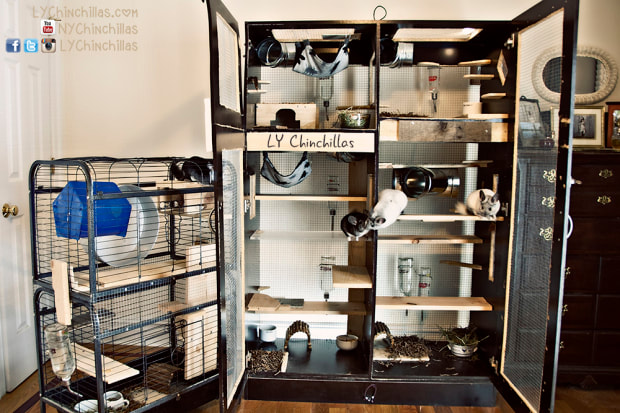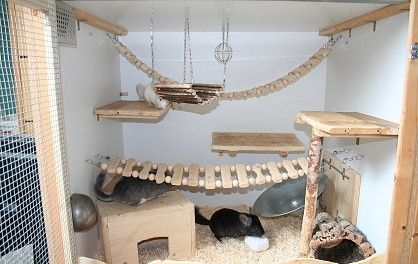General Information:
The long-tailed chinchilla (Chinchilla lanigera) belong to the family Chinchillidae and are part of the New World infraorder Caviamorphs (including chinchillas, degus, and Guinea pigs) which are histricognath rodents. Histricognath rodents are classified by the shape of their skulls.
Chinchillas are crepuscular rodents native to South America. They're found high up in the mountains - sometimes as high as 4270m! They typically live in amongst other chinchillas in small colonies called ‘herds’. Chinchillas typically live between 10-15 years, but ages up to 29 years have been reported - making them an enormous commitment.
Chinchillas come in a variety of coat colours, the most common being the 'standard grey'.
They’re adventurous and often mischievous little creatures, although they can be shy. Chinchillas are delicate and can 'slip fur' when mishandled, so be sure to handle them with care.
Care:
Housing/Enrichment:
Cages should be as large as possible and be made entirely from metal, ideally 2 metres high and 1 metre wide. Consider cages with a lot of height to mimic their natural environment. People sometimes convert a spare room for their chinchillas to access at will.
You should enrich their cage with plenty of safe wooden toys, including chinchilla boxes, branches, wooden shelving, and metal tunnels.
You can also buy your chinchilla a metal 'Tic Tac' wheel (minimum of 14 inches in diameter) for exercise. Ensure your chinchilla is of a suitable age before providing them with a wheel as kits are at a higher risk of overheating.
Glass bottles and ceramic bowls are recommended to prevent the chinchilla's from chewing.
Plastics are not recommended for chinchillas as they're very destructive and avid gnawers - internal blockages from plastic consumption have been reported.
The most popular ‘bedding’ for chinchillas are non-pill fleece covers that cover the bases/levels of the cage, but you can use loose substrates such as hemp, bedkind, and cardboard bedding. We prefer hemp as an option as we have witnessed sore hocks often on fleece, even if kept very clean.
In the wild, a chinchillas native environment is cool and dry. They’re very sensitive to extreme temperatures and struggle to regulate their body temperature, making them prone to heatstroke and even death. We recommend keeping your chinchilla in an environment that has a humidity level of about 50%-60% and temperatures of approximately 15°C-21°C.
Useful Links:
The long-tailed chinchilla (Chinchilla lanigera) belong to the family Chinchillidae and are part of the New World infraorder Caviamorphs (including chinchillas, degus, and Guinea pigs) which are histricognath rodents. Histricognath rodents are classified by the shape of their skulls.
Chinchillas are crepuscular rodents native to South America. They're found high up in the mountains - sometimes as high as 4270m! They typically live in amongst other chinchillas in small colonies called ‘herds’. Chinchillas typically live between 10-15 years, but ages up to 29 years have been reported - making them an enormous commitment.
Chinchillas come in a variety of coat colours, the most common being the 'standard grey'.
They’re adventurous and often mischievous little creatures, although they can be shy. Chinchillas are delicate and can 'slip fur' when mishandled, so be sure to handle them with care.
Care:
Housing/Enrichment:
Cages should be as large as possible and be made entirely from metal, ideally 2 metres high and 1 metre wide. Consider cages with a lot of height to mimic their natural environment. People sometimes convert a spare room for their chinchillas to access at will.
You should enrich their cage with plenty of safe wooden toys, including chinchilla boxes, branches, wooden shelving, and metal tunnels.
You can also buy your chinchilla a metal 'Tic Tac' wheel (minimum of 14 inches in diameter) for exercise. Ensure your chinchilla is of a suitable age before providing them with a wheel as kits are at a higher risk of overheating.
Glass bottles and ceramic bowls are recommended to prevent the chinchilla's from chewing.
Plastics are not recommended for chinchillas as they're very destructive and avid gnawers - internal blockages from plastic consumption have been reported.
The most popular ‘bedding’ for chinchillas are non-pill fleece covers that cover the bases/levels of the cage, but you can use loose substrates such as hemp, bedkind, and cardboard bedding. We prefer hemp as an option as we have witnessed sore hocks often on fleece, even if kept very clean.
In the wild, a chinchillas native environment is cool and dry. They’re very sensitive to extreme temperatures and struggle to regulate their body temperature, making them prone to heatstroke and even death. We recommend keeping your chinchilla in an environment that has a humidity level of about 50%-60% and temperatures of approximately 15°C-21°C.
Useful Links:
- BSAVA Manual of Exotic Pets (fifth edition)
- lafeber.com/vet/basic-information-for-chinchillas/
- www.rvc.ac.uk/Media/Default/Beaumont%20Sainsbury%20Animal%20Hospital/documents/caring-for-your-chinchilla.pdf
- www.littlepetwarehouse.co.uk/products/metal-aventura-huge-metal-rat-ferret-chinchilla-cage.html
- www.petplanet.co.uk/p28577/rat_and_ferret_cage_by_petplanet.aspx?ptm_source=google&ptm_medium=shopping&ptm_campaign=40to50_68616&campaign=439957091&adgroup=33472599131&keyword=&gclid=CjwKCAjw_o-HBhAsEiwANqYhp4AhmpEx313RjM_DcvDp4BCVaj5GffBkz9y1CW9bTUMDD9Sy1Poq3RoCkNAQAvD_BwE
- minipetz.co.uk/
- www.tictacwheels.co.uk/shop
- www.chinchilla-scientia.com/haltung/k%C3%A4fige-gehege-zimmer/zimmervorstellungen/ (translate to English)7
- msdvetmanual.com/exotic-and-laboratory-animals/rodents/chinchillas
Socialising:
Chinchilla's temperaments, like with most animals, can vary depending on the individual. Making a room chinchilla-safe for playtimes is recommended. Watching them explore and be entertained is one of the best ways to bond with your pet. Be sure to limit the length of playtimes and restrict playtimes completely on warmer days due to their sensitivity to heat. It is important to remember that chinchillas are prey species and are generally not fond of cuddles; they can show signs of affection in ways that are unique to them.
Chinchillas should not be kept solitary. Wild long-tailed chinchillas can live in groups of up to 100 individuals. If you have a lone chinchilla, consider contacting a local rescue about potentially finding your chinchilla a friend!
Diet:
Rodents have a vastly different digestive anatomy depending on the species. Closely related species such as that of the Caviomorph infraorder of New World histricognaths (such as chinchillas, Guinea pigs, and degus) still have varying digestive systems – particularly in the caecum and colon. The digestive system of chinchillas starts with the oesophagus which then leads to the stomach, to the small intestines (split into the duodenum, jejunum, and the ileum), to the large intestines, following on to the caecum, colon, and anus.
Chinchillas are monogastric herbivores; herbivores are typically classed as either fore-gut or hind-gut fermenters, with chinchillas being the latter. Hind-gut fermenters are then further categorized as either colonic or caecal fermenters.
Hind-gut fermentation allows for small rodents to consume and digest large quantities of a high-fibre, low-grain diet. The large caecum allows for recycling of nutrients that were not consumed during the first round of digestion, and a high-fibre diet is essential for this process to work effectively. Partially digested, nitrogen rich faeces known as caecotropes are formed at approximately 8-19 hours after consumption, these faeces are then reingested which is referred to as coprophagia. Chinchillas are vigorously more coprophagic when compared to other rodents such as hamsters, mice, and rats. Coprophagic behaviour is important as the caecotropes contain previously unabsorbed nutrients (Irlbeck and Pollock, 2011), these are then digested for a second time before producing a nitrogen-poor faeces that you'll usually see lying around.
When considering the anatomy and physiology behind digestion in the chinchilla, it is important that their body gets the required nutrition in captivity to allow for normal bodily functions. This involves ensuring they have a diet of mostly fibre, low-grains, and low protein. We understand that wild long-tailed chinchillas eating habits change seasonally as expected when they’re living in a food-poor environment. One study shows that fibrous materials made up 66% of their entire food intake throughout the years and seasons the chinchillas were monitored. Herbs and shrubs were also consumed in considerable quantities (with a preference for dead/dried plant matter documented), whilst succulents and seeds made up a very small proportion of the diet.
Nutrition is important in any animal as the body will use and require nutrients in order to maintain normal bodily functions and prevent many illnesses and diseases. Chinchillas have particularly sensitive herbivorous digestive systems and require high quantities of fibrous hay and grasses in order to function; it is advised that the majority of your chinchilla’s diet is hay. This fibrous material also aids in keeping their continuously growing teeth in the correct shape and can prevent severe dental disease. High fibre diets also help healthy gut-movement and prevents issues such as GI stasis – which can be life threatening.
Pelleted foods may be provided in small quantities; The accepted formula for chinchilla pellets is 16% to 20% protein, 2% to 5% fat, and 15% to 35% bulk fibre. Overfeeding pellets can be counter-intuitive and can contribute to health issues and disease as they are not a complete diet in of themselves. Healthy treats include; leaves, twigs, roots, and stems. You can feed very small quantities of fresh vegetables.
We feed our chinchillas:
If you’re a chinchilla owner, you will know that they’re often particularly fussy eaters. The most common food item chinchillas become fussy over is their hay.
If your pet becomes reluctant to eat their hay, we recommend the following:
Bathing:
The last essential part of chinchilla care is looking after their coat. In the wild, Chinchillas maintain their coat by bathing in the local fine sands. In captivity, it's still important to provide them with ways to keep their coat in top condition.
Never:
Useful Links:
Common Diseases:
Chinchillas are prone to a number of health issues. As prey species, they often mask illnesses incredibly well. It’s vital that you’re aware of the subtle signs and symptoms of some of the common diseases. We also highly recommend having a chinchilla-savvy vet already lined up.
Here are some of the common diseases:
Chinchilla's temperaments, like with most animals, can vary depending on the individual. Making a room chinchilla-safe for playtimes is recommended. Watching them explore and be entertained is one of the best ways to bond with your pet. Be sure to limit the length of playtimes and restrict playtimes completely on warmer days due to their sensitivity to heat. It is important to remember that chinchillas are prey species and are generally not fond of cuddles; they can show signs of affection in ways that are unique to them.
Chinchillas should not be kept solitary. Wild long-tailed chinchillas can live in groups of up to 100 individuals. If you have a lone chinchilla, consider contacting a local rescue about potentially finding your chinchilla a friend!
Diet:
Rodents have a vastly different digestive anatomy depending on the species. Closely related species such as that of the Caviomorph infraorder of New World histricognaths (such as chinchillas, Guinea pigs, and degus) still have varying digestive systems – particularly in the caecum and colon. The digestive system of chinchillas starts with the oesophagus which then leads to the stomach, to the small intestines (split into the duodenum, jejunum, and the ileum), to the large intestines, following on to the caecum, colon, and anus.
Chinchillas are monogastric herbivores; herbivores are typically classed as either fore-gut or hind-gut fermenters, with chinchillas being the latter. Hind-gut fermenters are then further categorized as either colonic or caecal fermenters.
Hind-gut fermentation allows for small rodents to consume and digest large quantities of a high-fibre, low-grain diet. The large caecum allows for recycling of nutrients that were not consumed during the first round of digestion, and a high-fibre diet is essential for this process to work effectively. Partially digested, nitrogen rich faeces known as caecotropes are formed at approximately 8-19 hours after consumption, these faeces are then reingested which is referred to as coprophagia. Chinchillas are vigorously more coprophagic when compared to other rodents such as hamsters, mice, and rats. Coprophagic behaviour is important as the caecotropes contain previously unabsorbed nutrients (Irlbeck and Pollock, 2011), these are then digested for a second time before producing a nitrogen-poor faeces that you'll usually see lying around.
When considering the anatomy and physiology behind digestion in the chinchilla, it is important that their body gets the required nutrition in captivity to allow for normal bodily functions. This involves ensuring they have a diet of mostly fibre, low-grains, and low protein. We understand that wild long-tailed chinchillas eating habits change seasonally as expected when they’re living in a food-poor environment. One study shows that fibrous materials made up 66% of their entire food intake throughout the years and seasons the chinchillas were monitored. Herbs and shrubs were also consumed in considerable quantities (with a preference for dead/dried plant matter documented), whilst succulents and seeds made up a very small proportion of the diet.
Nutrition is important in any animal as the body will use and require nutrients in order to maintain normal bodily functions and prevent many illnesses and diseases. Chinchillas have particularly sensitive herbivorous digestive systems and require high quantities of fibrous hay and grasses in order to function; it is advised that the majority of your chinchilla’s diet is hay. This fibrous material also aids in keeping their continuously growing teeth in the correct shape and can prevent severe dental disease. High fibre diets also help healthy gut-movement and prevents issues such as GI stasis – which can be life threatening.
Pelleted foods may be provided in small quantities; The accepted formula for chinchilla pellets is 16% to 20% protein, 2% to 5% fat, and 15% to 35% bulk fibre. Overfeeding pellets can be counter-intuitive and can contribute to health issues and disease as they are not a complete diet in of themselves. Healthy treats include; leaves, twigs, roots, and stems. You can feed very small quantities of fresh vegetables.
We feed our chinchillas:
- 80-85% high quality feeding hay (usually timothy)
- 10-15% dried forage and healthy treats
- 5% pelleted foods
If you’re a chinchilla owner, you will know that they’re often particularly fussy eaters. The most common food item chinchillas become fussy over is their hay.
If your pet becomes reluctant to eat their hay, we recommend the following:
- Purchase more than one brand of hay to keep things interesting
- Mix in healthy treats with their everyday hay to make it more appealing to them.
- They don't need constant access to pellets to stay healthy. You can alternate days which they have their pellets, or only give them access to them at certain times of the day. Some also remove these from the diet completely and increase forage intake.
- www.pfma.org.uk/chinchilas-nutritional-requirements
- www.rspca.org.uk/adviceandwelfare/pets/rodents/chinchillas/diet
- www.chinchilla-scientia.com/english-corner/nutrition/natural-chinchilla-diet/ (translate to English)
Bathing:
The last essential part of chinchilla care is looking after their coat. In the wild, Chinchillas maintain their coat by bathing in the local fine sands. In captivity, it's still important to provide them with ways to keep their coat in top condition.
Never:
- Bathe your chinchilla with water
- Use building or play sand in their baths
Useful Links:
- www.chinchilla-scientia.com/hygiene-pflege/fellpflege/das-sandbad-zweck-sandart-hygiene-und-alternativen/ (translate to English)
- www.amazon.co.uk/JR-Farm-Chinchilla-Sand-Special/dp/B001MZWT5G
- www.petsathome.com/shop/en/pets/bathing-dust-for-chinchillas-3kg?weight=3kg?utm_source=google&utm_medium=cpc&utm_campaign=google_shopping&cm_mmc=Google-_-CPC-_-%20google_shopping-_-google_shopping&ita=1976&ito=google_shopping&istCompanyId=7255ccad-a1fc-4729-af31-478f79e5071c&istFeedId=385e6b9a-8b03-4076-a8bb-e4737df8549c&istItemId=itxmxptil&istBid=tzwt&gclid=CjwKCAjw_o-HBhAsEiwANqYhp6Lw-1gnWSxr2t9AuDtRUpPa5NQjR_J17ZFjS8cCS1JWTgx6_sFChRoCcV8QAvD_BwE&gclsrc=aw.ds
Common Diseases:
Chinchillas are prone to a number of health issues. As prey species, they often mask illnesses incredibly well. It’s vital that you’re aware of the subtle signs and symptoms of some of the common diseases. We also highly recommend having a chinchilla-savvy vet already lined up.
Here are some of the common diseases:
- Dental disease: All of the chinchillas teeth grow continuously. The incisors are naturally orange, whereas the molars are cream. Their teeth are well equipt to deal with their natural diet consisting of high amounts of abrasive and fibrous grasses. A diet high in pellets will not wear down all the teeth effectively and will lead to dental diseases.
Many dental diseases have been documented in chinchillas such as malocclusion, odontomas, caries, tooth resorption, and periodontal and endodontic diseases.
Symptoms of dental disease in chinchillas include; ptyalism (drooling) which can cause matting of the fur around the mouth, anorexia (not eating), watery eyes (particularly when tooth root elongation occurs), and weight loss secondary to anorexia. It’s vital these issues are addressed urgently as dental disease can be fatal if left untreated. - Heat stroke: Chinchillas are very sensitive to extreme temperatures. Prolonged exposure to temperatures higher than 28°C (80°F) can cause hyperthermia, secondary gastrointestinal stasis, shock, dehydration and more. Symptoms such as ptyalism, panting, extremely red ears, and lethargy are all a cause for action. It’s very important you don’t rapidly attempt to bring down your chinchillas body temperature. Veterinary attention should be sought if you think your chinchilla has heat stroke.
- Cardiac issues: Chinchillas can present with dilated cardiomyopathy, heart murmurs, and arrhythmia. These issues may be congenital, or they can be due to diet (vitamin E or selenium deficiency, a diet too high in fats or calcium), or as a result of obesity. These can be diagnosed by an experienced veterinarian via radiographs, echocardiograph, or electrocardiography.


